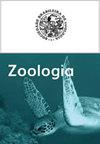Living among thorns: herpetofaunal community (Anura and Squamata) associated to the rupicolous bromeliad Encholirium spectabile (Pitcairnioideae) in the Brazilian semi-arid Caatinga
IF 1.8
4区 生物学
Q4 ZOOLOGY
引用次数: 7
Abstract
Bromeliads are important habitats for reptiles and amphibians, and are constantly used as shelter, refuge, foraging or thermoregulation sites due to their foliar architecture, which allows for constant maintenance of humidity and temperature. This study aimed to identify the herpetofauna inhabiting the non-phytotelmata rupicolous bromeliad Encholirium spectabile Mart. ex Schult. & Schult.f. and to analyze the microhabitat usage of these bromeliads by different species in the Caatinga of northeastern Brazil. From January 2011 to August 2012, we collected data by active search throughout three paralel transects in a rock outcrop in the municipality of Santa Maria, state of Rio Grande do Norte. We recorded four species of anuran amphibians, six lizards, and seven snakes in the bromeliads. The average air temperature was lower and air humidity higher inside than outside the bromeliads, and bromeliads at the rock outcrop borders had lower temperatures and higher humidity than those at the center. We found a significant difference in the distribution of individuals throughout the rock outcrop, with most specimens found at the borders. We also found significant differences regarding the use of each microhabitat by the taxonomic groups, with lizards and snakes using green leaves and dry leaves evenly, along with fewer records in inflorescence stems, and anurans mainly using green leaves, with few records on dry leaves, and no records in the inflorescence stems. This study highlights rupicolous bromeliads as key elements in the conservation and maintenance of amphibians and reptiles in the rock outcrops of Brazilian semi-arid Caatinga.生活在荆棘中:巴西半干旱Caatinga地区与胡桃科凤梨科Encholirium spectabile (Pitcairnioideae)相关的爬行动物群落(无尾目和鳞片目)
凤梨科植物是爬行动物和两栖动物的重要栖息地,由于其叶面结构,可以持续保持湿度和温度,因此经常被用作庇护所、避难所、觅食或体温调节场所。本研究的目的是鉴定栖息在非植物端部科的凤梨科的爬行动物。Schult交货。& Schult.f。并分析巴西东北部Caatinga不同物种对凤梨科植物微生境的利用情况。从2011年1月到2012年8月,我们在北里奥格兰德州圣玛丽亚市的一块岩石露头的三个平行横断面上积极搜索,收集了数据。我们在凤梨群中记录了4种无尾两栖动物、6种蜥蜴和7种蛇。凤梨座内部平均气温较低、空气湿度较高,露头边缘的凤梨座温度较低、空气湿度较高。我们发现整个岩石露头的个体分布有显著差异,大多数标本都是在边界发现的。不同类群对各微生境的利用也存在显著差异,蜥蜴和蛇类对绿叶和干叶的利用较为均匀,在花序茎上的记录较少;无尾目动物主要利用绿叶,在干叶上的记录很少,在花序茎上没有记录。这项研究强调了在巴西半干旱的Caatinga露头岩石中,rupicolous bromeliads是保护和维持两栖动物和爬行动物的关键因素。
本文章由计算机程序翻译,如有差异,请以英文原文为准。
求助全文
约1分钟内获得全文
求助全文
来源期刊

Zoologia
生物-动物学
自引率
0.00%
发文量
15
期刊介绍:
Zoologia, the scientific journal of the Sociedade Brasileira de Zoologia (SBZ), is an international peer-reviewed, open-access Zoological journal that publishes original research on systematics, evolution, taxonomy, nomenclature, biogeography, morphology, physiology, biology, ecology, symbiosis, conservation, behavior, genetics and allied fields. The journal, formerly known as Revista Brasileira de Zoologia, publishes original articles authored by both members and non-members of the Society. The manuscripts should be written exclusively in English.
 求助内容:
求助内容: 应助结果提醒方式:
应助结果提醒方式:


